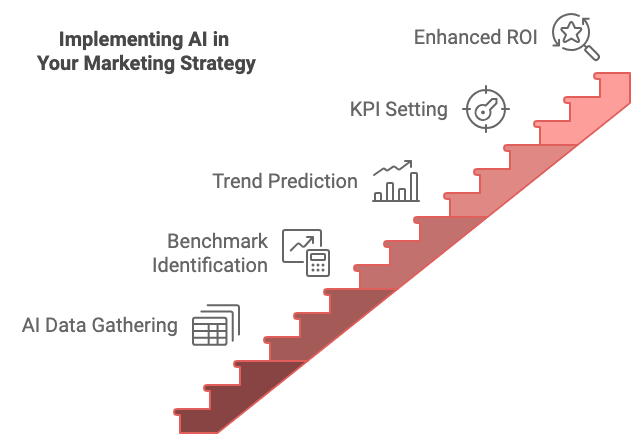Gathering Meaningful Data for Your Marketing Strategy


In this second article of our three-part series, we will explore the tactics of gathering accurate and useful data for MedTech digital marketing. Following our initial discussion on the importance of data, we now turn our focus to the tools and methods available to collect valuable data across various marketing channels, including email marketing, social media (specifically LinkedIn), website performance, and SEO. Additionally, we will explore how AI can aid in interpreting this data by providing benchmarks for comparison and explaining the significance of different key performance indicators (KPIs).
Tools for Gathering Data
Email Marketing
Email marketing platforms like HubSpot, Mailchimp, and Constant Contact offer comprehensive data collection tools. These platforms allow you to track the entire user journey through your email, from open rate to click-maps showing exactly where your audience clicked. You will be given a performance report for every email sent through your platform, in which you can review the amount of time the readers actually spent in the email, which content in the email was most engaged versus most skimmed over, and how performance varied across readers’ devices.
When choosing an email marketing platform, consider the different data analysis tools each offer and which best suits your company’s needs. HubSpot allows you to see which individual contacts received, opened, clicked on content, and unsubscribed from an email. Mailchimp offers suggestions to improve read-through and click-through rates for your next email based on the performance of the last one.
Your email marketing platform’s analysis can help you better understand what your audience is interested in and engaged with. This will not only improve your email marketing performance but also give you a better insight into your audience and the messaging that resonates with them in your marketing campaigns.
Social Media
Similar to the email marketing platforms previously discussed, all social media platforms have built-in free analysis tools for business pages. In this age of social media, we all know that engagement rate and follower growth are key metrics to keep an eye on, but what does it actually mean for your business?
Regularly checking your post engagement gives you the information you need to refine your messaging and content to better capture your audience’s attention. A 7% engagement rate and two new followers from a single post might not be significant to your business. However, noticing that each time you post about your team, you receive more comments and shares from your target demographic than usual, or that when you use a specific hashtag or call to action in the caption, you get more clicks to your website, you can adjust your social media strategy to focus on creating content that generates meaningful results for your business.
With social media especially, it is important to look at the trends and overall page performance rather than specific posts’ metrics. Anything can go viral or significantly underperform for a multitude of reasons beyond your control; these instances are often flukes. Consistent trends in data can turn your social media into an effective lead conversion tool.
Website
Website performance is crucial for understanding how visitors interact with your company’s site, and Google Analytics is the leading tool across industries to get such insights. It tracks important metrics like:
- Total page views, the amount of time users spent on each page on average, engagement on each page, and conversion rates (the percentage of users who complete actions like signing up for newsletters or making purchases).
- Traffic source, or how each user ended up on your site as well as user journey, or how users traveled through your site
- Your audience demographics and what kind of devices and browsers they are using to access your site
- And more!
In addition to Google Analytics, which is free to integrate into your site, there are paid tools like Hotjar and Umami that provide more detailed insights into user behavior. These platforms offer heatmaps that visually represent where users click and scroll, highlighting the most and least engaging areas of your website. Session recordings allow you to watch how users navigate your site, helping you spot any friction points or confusing layouts. By combining these insights, you can make informed decisions on improving your website’s design and content to enhance user experience and increase conversions.
SEO
In conjunction with website analytics, effective SEO relies on tools like Google Search Console and SEMrush to monitor key metrics that affect your website’s visibility. These tools help you track keyword performance and highlight which search terms drive the most traffic to your site. Additionally, proper utilization of keywords allows you to monitor your search engine rankings, helping you understand and improve where your site stands when users go to search engines like Google with questions about your industry, services or products. Tracking organic traffic is crucial, as it shows how many visitors find your site through search engines without spending money on ads.
Regularly analyzing this data and continuously refining your SEO strategy is a cost-effective way to boost website traffic and online visibility for your brand. By understanding which keywords and backlinks are most effective for your company, you can optimize your content to improve search rankings and drive more organic traffic. This ongoing analysis helps ensure your website remains competitive among the thousands and thousands of results search engines like Google present to your audience.
Utilizing AI


AI plays an increasingly helpful role in improving data analysis by streamlining the data gathering and analysis processes. AI tools can automatically gather and organize data from multiple sources, saving time and reducing the risk of human error. This allows businesses to focus on analyzing insights rather than spending time on manual data gathering.
AI also helps identify industry benchmarks, clearly comparing your performance against competitors or industry leaders. By analyzing large datasets, AI can provide valuable context for how well your strategies work and even suggest ways to improve your digital footprint. Additionally, AI algorithms can detect patterns and predict future trends, giving you the foresight to adjust strategies and stay ahead of market shifts. This predictive capability is particularly useful for businesses looking to remain competitive in an ever-evolving digital landscape.
Many of the tools previously mentioned for email, social, and website analytics have their own AI software built into their platforms either for free or a small up-charge. ChatGPT, Julius AI and Claud are recognized as leaders in AI, especially in terms of data analysis for businesses, across industries internationally and are continuing to improve their algorithms constantly.
Understanding KPIs and Goal Setting
AI plays a significant role in setting KPIs (key performance indicators) and highlighting their importance in marketing strategies. These tools help take the guesswork out of converting your business goals into a marketing strategy and setting realistic goals for your marketing team. For example, AI can identify which metrics, such as email open rates or social media engagement, have the biggest impact on your overall lead conversion. This ensures that the KPIs you focus on are tailored to your business needs, allowing you to track the metrics that truly matter.
AI also helps identify industry-specific benchmarks by comparing your KPIs to industry standards and competitor performance. This comparison provides valuable context, allowing you to understand whether your metrics are on track or require improvement. By guiding the selection and analysis of KPIs, AI ensures that your marketing efforts remain focused on achieving measurable, data-driven success, without hours of research and manual work from your marketing team.
To really nail digital marketing in the MedTech field, it’s all about getting your hands on data that’s both accurate and really useful. Using the right tools and leveraging AI can uncover invaluable insights into your marketing efforts across all digital channels. Understanding and analyzing KPIs will enable you to make data-driven decisions, optimize your strategies, and ultimately enhance your marketing ROI.
Stay tuned for the final article in our series, discussing how to implement data-driven strategies effectively.













